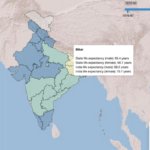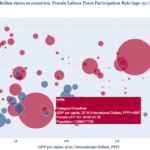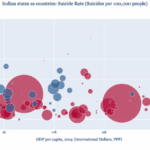Picture This: If Indian States Were Countries – Life Expectancy
Life expectancy is an important metric that assesses both a population’s health and a country’s healthcare system. It is a measure of the average time a person is expected to live in a country. According to the United Nations, the world had a global life expectancy of 72.6 years in 2019. This was a vast improvement over the global average of only 46 years in the year 1950.
However, averages tend to hide as much as they reveal. For example, in 1950, the world may have had an average life expectancy of 46 years, but this number hides the variation across countries. E.g., the United States had a life expectancy of 68 years in 1950 but India’s average was only 35 years.
But how do Indian states compare with the rest of the world when it comes to life expectancy? In this second part of our series on Indian states as countries, we compare Indian states with other countries in the world which have a similar life expectancy.
Life expectancy for Indian states has been taken from the SRS Based Abridged Life Tables 2014-2018 published by the Office of Registrar General & Census Commissioner, India. This data shows that between 2014 and 2018 India’s average life expectancy was 69.4 years. According to World Bank, in the year 2018, global average life expectancy was 72.6 years. Life expectancy for other countries in the year 2018 has been taken from the World Bank’s database.
Among Indian states, we find that Kerala and NCT of Delhi had the highest life expectancy in India at 75.3 years. If Kerala or NCT of Delhi were countries, they would find themselves at par with Vietnam in life expectancy. Jammu and Kashmir had the next highest life expectancy in the country at 74 years and it found itself almost at par with Guatemala which had a life expectancy of 74.1 years.
Across India, only five states (Kerala, NCT of Delhi, Jammu and Kashmir, Himachal Pradesh, and Punjab) had life expectancy at par or higher than the World Bank global average of 72.6 years. India’s most industrialized state of Maharashtra had a life expectancy of 72.5 years and had it been a country, it would have found itself slightly ahead of Bangladesh (72.3 years).
Karnataka (69.4), Odisha (69.3), Bihar (69.1), and Jharkhand (69.1) find themselves closest to Botswana (69.3) in terms of life expectancy.
Among the bottom ranked states in India in terms of life expectancy, Madhya Pradesh at 66.5 years is closest to sub-Saharan African nation, Djibouti while Uttar Pradesh (65.3), and Chhattisgarh (65.2) are closest to the north African nation, Sudan (65.1).
If you wish to republish this article or use an extract or chart, please read CEDA’s republishing guidelines.







